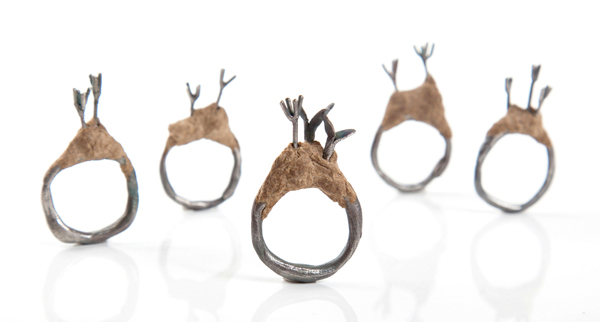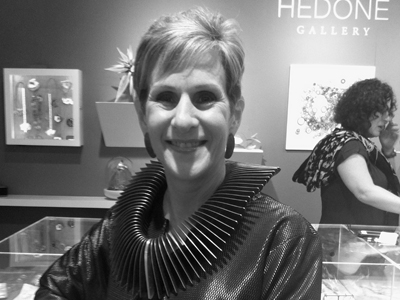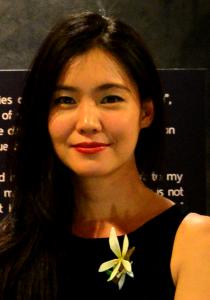
Bonnie Levine: Tell me about your background. How did you become interested in making jewelry since there is not a long tradition of art jewelry in Thailand? Who has had a major influence on your work?
Rudee Tancharoen: My introduction to art jewelry is quite a delightful coincidence. After I graduated in industrial design from Chulalongkorn University, Thailand, I worked as a designer for a while. However, I found that there are some aspects of industrial work that did not quite agree with me. I wanted to try something else where I could still use my creativity, but involved less in industrial business. I then decided to take a three-year course at the Alchimia school in Florence, Italy, where I was introduced to and graduated in the art of contemporary jewelry.
During my last year at Alchimia, I had an opportunity to study with Manfred Bischoff for a whole year and his philosophy has had a major influence on my work in several aspects.

Bonnie Levine: Tell me about your background. How did you become interested in making jewelry since there is not a long tradition of art jewelry in Thailand? Who has had a major influence on your work?
Rudee Tancharoen: My introduction to art jewelry is quite a delightful coincidence. After I graduated in industrial design from Chulalongkorn University, Thailand, I worked as a designer for a while. However, I found that there are some aspects of industrial work that did not quite agree with me. I wanted to try something else where I could still use my creativity, but involved less in industrial business. I then decided to take a three-year course at the Alchimia school in Florence, Italy, where I was introduced to and graduated in the art of contemporary jewelry.
During my last year at Alchimia, I had an opportunity to study with Manfred Bischoff for a whole year and his philosophy has had a major influence on my work in several aspects.
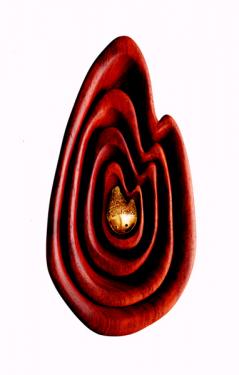
Rudee Tancharoen: Nowadays there are more Thai people, like me, who furthered their education abroad, specializing in art jewelry. Some chose to make their careers in Europe while some chose to come back and try to introduce art jewelry to people here in Thailand.
I myself established Atelier Rudee, which, besides running regular technical courses, also hosts artist talks and conceptual workshops. And ATTA Gallery, specializing in contemporary art jewelry, presents both foreign and local artists. Often the artists from abroad who have a show at ATTA Gallery also run a workshop at Atelier Rudee, either before or after the show. This way the audience can get a big picture of what art jewelery is, how it is made as well as how it is presented at the gallery.
So far, we have gained more and more interest from wider ranges of participants such as designers, architects, writers, photographers, ceramics artists, etc., including traditional jewelers. We still have a long way to go, but the future looks optimistic.
You’ve studied in Italy, Germany, and Austria. How did this influence your work? Why did you decide to go back to Thailand after completing your studies in Italy?
Rudee Tancharoen: During the 6 years in Europe I traveled around to see and learn about art and art jewelry as much as possible. I studied with Manfred Bischoff for a year, participated in summer workshops with Caroline Broadhead and Esther Brinkmann, and participated in short workshops with Iris Eichenberg, Peter Skubic, and Iris Bodemer. They have definitely influenced my work in several ways, from the thinking process, source of inspiration, how to transfer the idea into the pieces, choice of materials and techniques including the aesthetic of the work.
It would be a pity to keep those fascinating things I’ve learned only to myself, so I decided to come back to my home country and introduce them to people who are interested.

Rudee Tancharoen: To me, art jewelry is an art object to be worn or carried along with a person. It is one of the main issues that I’ve considered in creating this series of work. My jewelry is not made for body decoration, but the pieces are objects to carry with the body, to remind the carrier of their existence and context. The “work” not only refers to the jewelry pieces but the whole experience that the audience would receive from the show.
Even without intent, it is hard to deny that the current political situation in my country has an influence on my work. What are the problems? How can we solve them? How are we going to overcome it? How can we prevent it from recurring? I’ve found that many problems and questions I have, not only political problems but also other general matters in everyday life, led me to the same answers. That is why I call it “the Truth.”
The main message of this work is the importance of Sati, or mindfulness, which is the answer to the questions. Therefore, through the exhibition, the audience sees their whole body reflected in a mirror before entering into a silent, pitch-black exhibition space with the sound of water dropping in the background. I would like to guide their minds from the confusing outside world back into themselves to observe the pieces with Sati. Each work has its own story relating to Sati, represented through cartoonish characters.
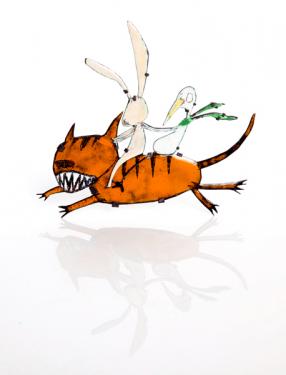
Words are powerful. They could construct or destroy.
Words are quick. Once they are launched, they cannot be retrieved.
Let’s not allow words to travel alone without companions.
Accompany them with thought and kindness. Guide them through listening and looking.
The piece, words, or actions are represented by a leaping tiger, accompanied by a rabbit with extra long ears and a large-eyed bird on the back, which represent listening and looking.
The pieces in the show are in various materials (wood, copper, silver, enamel) and some have a naïve and cartoon–like quality. Can you tell us about that?
Rudee Tancharoen: The messages are there and I need a language to communicate. The message itself is serious, therefore I chose to communicate with a language that is easy to perceive, to invite people to come closer and observe the work. Their cute-looking character attracts the audience’s attention and hopefully opens their hearts for the messages.
For the choice of materials, recently I have had chances to learn and develop my skill in several techniques and to handle different kinds of material. It is too exciting for me to limit myself to only one material or technique. I wanted to see what I can do with what I’ve learned. However, I chose certain materials and techniques for certain messages that I think are appropriate.
You mentioned that you started Atelier Rudee, the first and only international academy of contemporary jewelry in Thailand. This is a huge and impressive undertaking. What was your vision and mission for starting this academy?
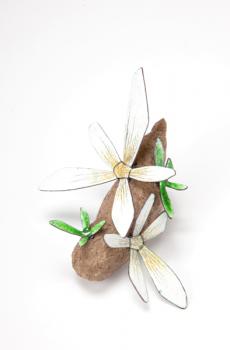
Atelier Rudee’s mission is to introduce and provide a basic understanding of contemporary art jewelry. We would like to see innovations, based on true understanding and not only improvement of superficial image. Besides the richness of arts and cultural resources, Thailand is also one of the most popular vacation destinations. There are numerous interesting places to visit, good food and tropical fruits, it is easy to reach, and the living cost is reasonable. With all these factors combined, taking a decision to come to Atelier Rudee would be a joy and educational.
What kind of courses and activities are offered? Is it achieving your objectives? What impact is it having?
Rudee Tancharoen: At Atelier Rudee we do not only teach the techniques of creating jewelry. Besides regular technical courses, we also invite notable contemporary jewelry artists such as Ruudt Peters (co-organized with ATTA Gallery), Philip Sajet, Beate Klockmann, Katja Prins, and Marie-Louise Kristensen, as well as young talented artists such as Tabea Reulecke, Märta Mattsson, Nora Rochel, Bernhard Stimpfl-Abele, Yuki Sumiya, Meiri Ishida, and Yiumsiri Kaï Vantanapindu to give artist’s talks and/or conceptual workshops. These activities provide an overview of what contemporary art jewelry is and help the participants to understand the disciplines involved. It is hard at the beginning because contemporary art jewelry is not widely known here, but it is getting better as we slowly build up a nice group of audiences who keep coming back.
Besides activities at Atelier Rudee, we also organize excursions to see and learn craftworks such as ancient casting, ancient pottery making, cotton and silk weaving with natural color dying, etc. from craftspeople in small villages in Thailand. The objective is to create a bridge between craftsmen, artists, and designers regardless of nationality. We hope that it is an opportunity for both the participants and the craftspeople to observe and learn from each other. On our previous trip, the participants had fun, gained knowledge in craftwork as well as culture, and brought back with them the pieces they made. At the same time, the activity not only brings business to the community, it also stimulates the villagers’ awareness of the value and importance of carrying on local knowledge.
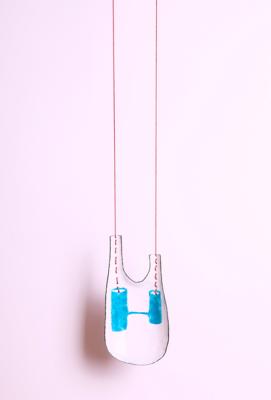
Rudee Tancharoen: After being away from home for almost six years, I felt thirsty for more profound knowledge regarding my own roots. I read more books that reflect on Thai and Asian culture and beliefs such as Heart-Wood from the Bo Tree, written by Buddhadasa Bhikkhu. The book is about the philosophy of voidness that lies at the heart of Buddhism, presented in simple language.
Vetal Panchavimshati is a collection of tales and legends within a frame story from India. Mūbān lek trakūn pao, a 20th century Chinese fiction written by Anyi Wang, has been translated into Thai by Her Royal Highness Princess Maha Chakri Sirindhorn. As H.R.H Princess Sirindhorn has mentioned in the preface, which can be translated as follows, “In this fiction, the writer describes human nature in different circumstances among the rapid changing society by reflecting on the ways of life of the villagers in a rural area of China in the beginning of 1960. … The fiction Mūbān lek trakūn pao seems to be an invitation for readers to observe themselves profoundly through a variety of characters in the story, which represent ‘beauty’ and ‘ugliness’ that will be held harmoniously in human nature. This fiction therefore could be a challenge for readers to look through complicated dimensions of themselves in order to sustain their intellect, which will enable them to truly ‘love’ and ‘understand’ fellow men.”
